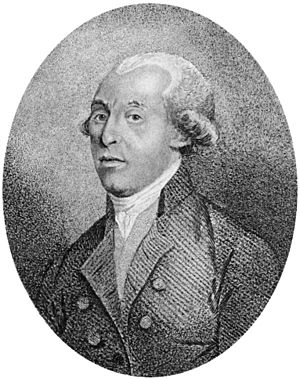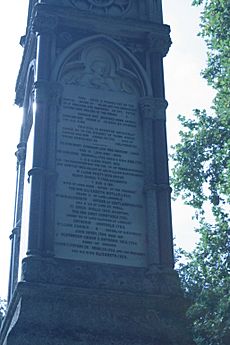Tiberius Cavallo facts for kids
Quick facts for kids
Tiberius Cavallo
|
|
|---|---|
 |
|
| Born | 30 March 1749 |
| Died | 21 December 1809 (aged 60) London
|
Tiberius Cavallo was a smart Italian scientist who lived from 1749 to 1809. He was very curious about how the world works. His main interests included electricity, making better scientific instruments, and studying different types of gases. He was also fascinated by hot air balloons.
Cavallo became a member of important science groups. He joined the Royal Academy of Sciences in Naples. In 1779, he also became a Fellow of the Royal Society in London. From 1780 to 1792, he gave the famous Bakerian Lecture at the Royal Society thirteen times in a row!
Contents
Life and Discoveries
Early Life and Moving to England
Tiberius Cavallo was born in Naples, Italy, on March 30, 1749. His father was a doctor. In 1771, when he was 22 years old, Cavallo moved to England.
Inventing Scientific Tools
Cavallo was very good at making scientific instruments better. He is often known for inventing a tool called "Cavallo's multiplier." This device helped make small electric charges stronger. This way, scientists could see and measure them more easily. He also created a "pocket electrometer." This was a small tool used to detect electricity.
Experiments with Cooling
Cavallo also worked on how to make things cold, which is called refrigeration. Other scientists had done some work on this before him. But in 1781, Cavallo was the first to do many careful experiments. He used liquids that evaporate quickly to create a cooling effect.
Studying Gases and Balloons
Cavallo was very interested in the properties of different "airs" or gases. He did experiments with "inflammable air," which we now call hydrogen gas.
In 1781, he wrote a book called Treatise on the Nature and Properties of Air. In this book, he looked at the ideas of other scientists. He discussed the phlogiston theory and the different views of Antoine Lavoisier.
In June 1782, Cavallo wrote a paper for the Royal Society. It described his attempt to lift a balloon using hydrogen gas. This was one of the very first tries!
His book, History and Practice of Aerostation (1785), was very important. People thought it was one of the best books about ballooning from that time. In it, Cavallo talked about recent balloon experiments. He also explained the science behind how balloons work. He wrote this book for everyone, not just scientists. He avoided difficult words and math. This made him a great science communicator. His work helped inspire early balloonists like Jacques Charles and Jean-Pierre Blanchard.
Music and His Legacy
Cavallo also wrote about music. He published a book about how musical instruments are tuned. It was called Of the Temperament of Those Musical Instruments, in Which the Tones, Keys, or Frets, are Fixed, as in the Harpsichord, Organ, Guitar, &c.

Tiberius Cavallo passed away in London on December 21, 1809. He was buried in the Old St Pancras Churchyard. His grave is now lost. However, his name is listed on the Burdett Coutts memorial. This memorial honors many important people buried there.
Works
Tiberius Cavallo wrote many books about different areas of physics. Some of his important works include:
- Theory and Practice of Medical Electricity (1780)
- History and Practice of Aerostation (1785)
- Medical Properties of Factitious Air (1798)
- Elements of Natural and Experimental Philosophy (1803)
He also wrote articles for a large encyclopedia called Rees's Cyclopædia. He contributed to topics like Electricity, Machinery, and Mechanics.
Images for kids






